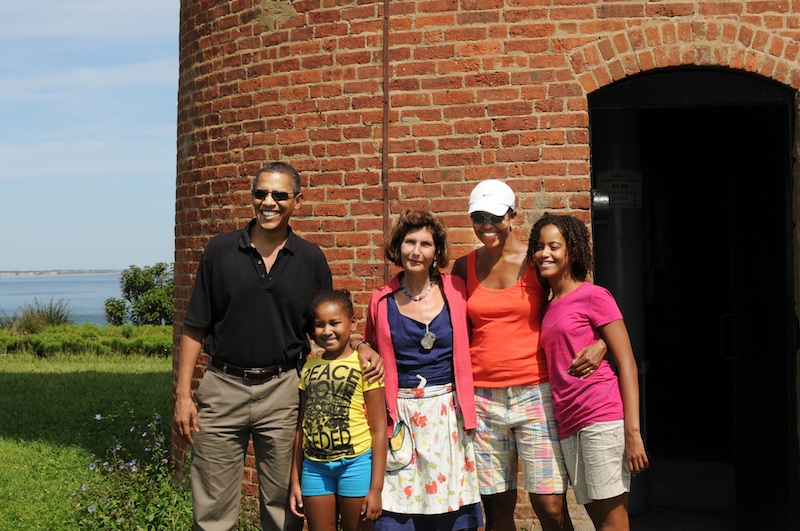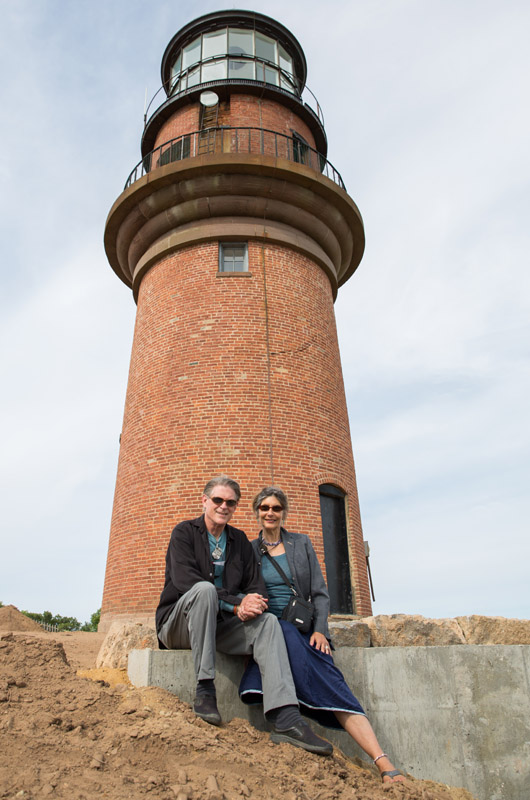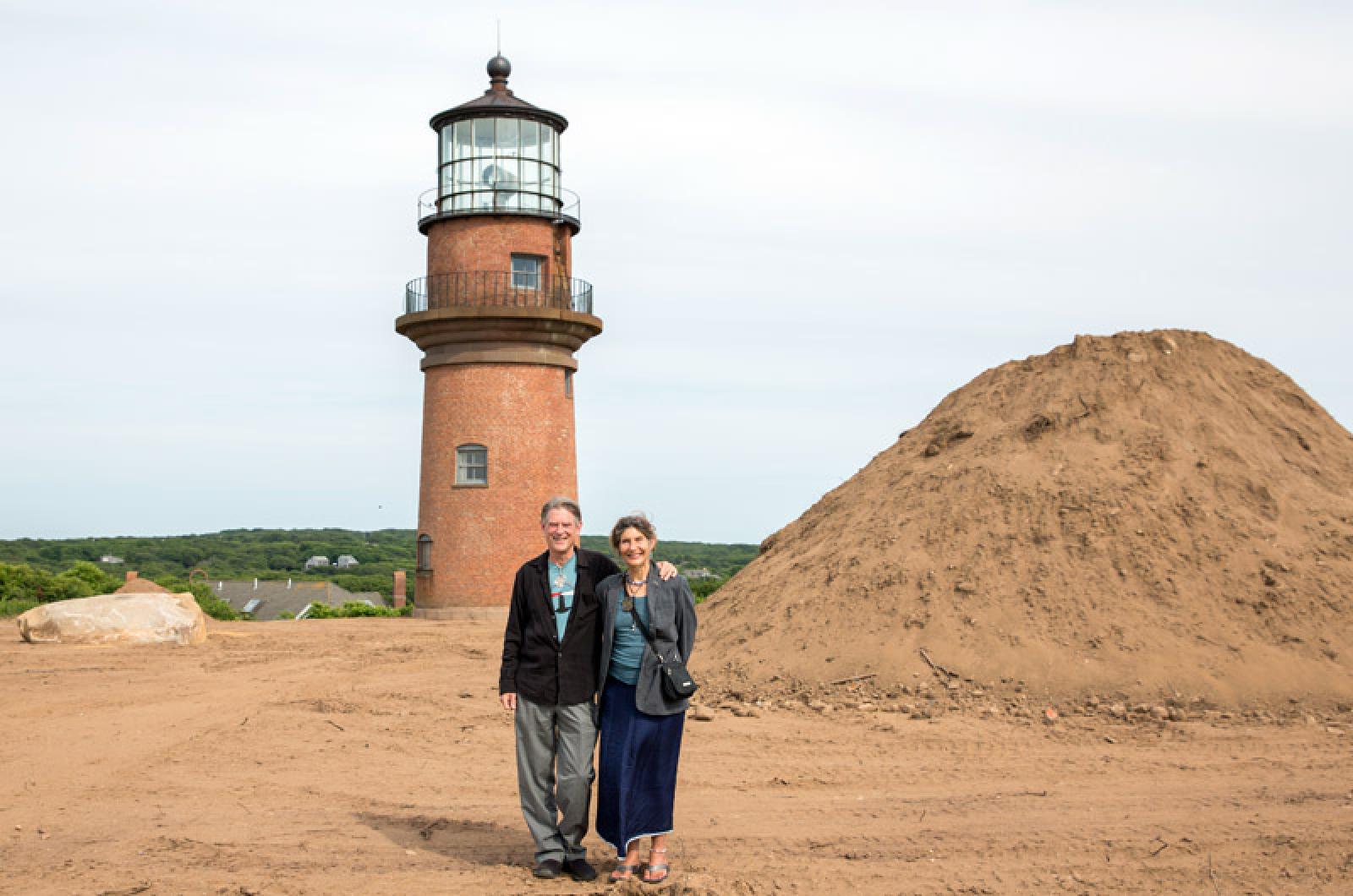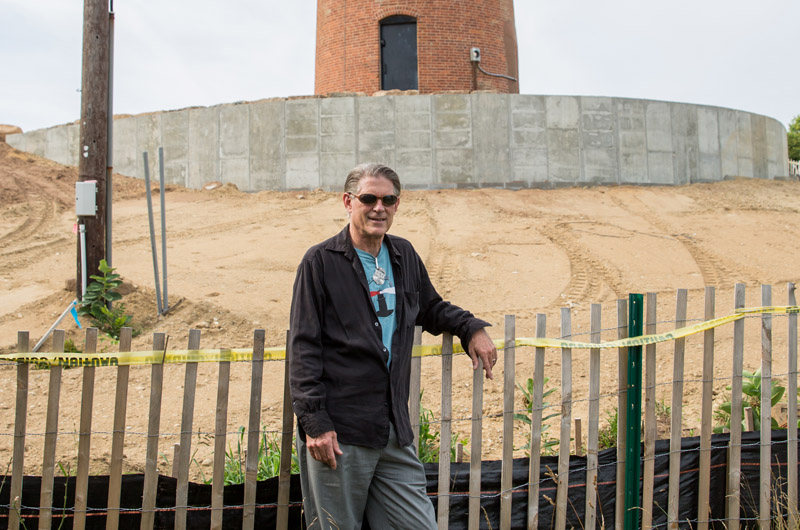On a hot, sunny evening last week, Richard Skidmore and Joan LeLacheur sat at a picnic table on the porch of a small cottage at Aquinnah Circle that has served as headquarters for the Gay Head Light relocation project.
The soft-spoken couple carried their metal lightkeeper’s badges; Mr. Skidmore’s was clipped to his shirt and Ms. LeLacheur’s to her purse. Each badge bore the image of a lighthouse and the words U.S. Lighthouse Service. The U.S. Coast Guard assumed control of the country’s navigational aids in 1939, but the badges still exude a sort of timeless authority.
Mr. Skidmore, a former book reviewer for the New York Times, and Ms. LeLacheur, a wampum jewelry maker, have lived by the particular rhythms of the Gay Head Light for 25 years, tending to its mishaps and arranging countless visits with people from around the world. Like many Aquinnah residents, they have grown fond of the red and white sweep of the light through their windows at night.
When the beacon was extinguished in May as part of a major project to move the lighthouse away from an eroding cliff, residents wondered whether the light would still reach their windows. “A big part of their sense of place is having that light go by,” said Mr. Skidmore, who spearheaded the relocation efforts five years ago and is looking forward to the relighting this summer.

But this isn’t the first time the Gay Head Light has been saved, he said. In 1985 the Coast Guard planned to tear it down and replace it with a metal pole and blinking light. William Waterway (who would later publish a history of the lighthouse), with the support of Sen. Ted Kennedy and others, negotiated a lease agreement that gave his nonprofit, Vineyard Environmental Research Institute, control of the lighthouse. It was the first time in U.S. history that a civilian organization had taken control of an active lighthouse.
A few years later at the Aquinnah Shop, a mutual friend introduced Mr. Skidmore and Ms. LeLacheur to Mr. Waterway, who invited them up the lighthouse to watch the sunset. On the way down from the glass-paned light room, still awed by the experience, Ms. LeLacheur said to their host, “I think I should be working for you.” Before long, she and Mr. Skidmore would be opening the lighthouse to the public on weekends at sunset. “That went on for 20 years,” Ms. LeLacheur said.
In 1994, Mr. Waterway transferred his lease to the Martha’s Vineyard Museum (then the Dukes County Historical Society) and the couple stayed on as lightkeepers. They now work for the town of Aquinnah, which took ownership of the lighthouse property in February as part of the relocation project.

Over the years, they have maintained the 1856 brick-and-masonry lighthouse and kept its heavy metal door open to visitors for much of the year. “Just about every part of the building has been worked over to some degree,” Mr. Skidmore said.” The structure survived the 129-foot move without a single crack — most likely the result of careful and consistent lightkeeping since the 1980s. A more extensive restoration of the building will begin this year.
The couple has faithfully kept watch over the Gay Head Light longer than any of its keepers so far, with the exception of Ebenezer Skiff, who kept the original 1799 wooden lighthouse for 29 years. (Incidentally, that lighthouse was also saved from the eroding cliffs using house-moving technology.) “I’m wanting to match him,” Mr. Skidmore said. “So after that, we’ll see.”
Some moments in their tenure still stand out. Ms. LeLacheur remembers hosting the Obamas in 2009 during their first presidential vacation on the Island. According to the guest book, one of many now archived at the Martha’s Vineyard Museum, it was a “beautiful, cool day.” The Secret Service had kept Ms. LeLacheur locked inside the lighthouse all morning, but when the first family arrived, she dutifully led them up to the light room, where they stood in awe of the clay cliffs below, the open ocean and Cuttyhunk and Rhode Island to the west.
In 2010, Mr. Skidmore arrived at the property one day to find that 40 feet of the cliff had disappeared, leaving just 53 feet between the cliff and the lighthouse. Most of the proposed solutions fell short: an underground wall between the structure and the cliff, a layer of organic matting held to the cliff face with 15-foot screws. Eventually Mr. Skidmore and a small group of Aquinnah residents announced that the light would have to move, and quickly.
On a rainy day in June, Mr. Skidmore found himself in a construction vest and hard hat, overwhelmed with emotion as the lighthouse inched its way to safety along two enormous steel beams. “I was in an altered state of consciousness,” he said. “This was something I had been working towards for five years and the fact that it was actually happening was just beyond comprehension.”
He remembers standing directly below the 400-ton structure a few days later, as it was carefully lowered onto its new foundation. Workers guided the large central support column inside the lighthouse over a new column that would connect it to the foundation. “To me this was like the mating of heaven and earth,” Mr. Skidmore said. “And that out of this moment of conception some months later, the light would be reborn.”
Two film documentaries now in the works will likely include Mr. Skidmore and the many others who helped save the lighthouse. But their journey is far from over. After the relighting this summer, Mr. Skidmore will help oversee a period of extensive renovations inside and outside the lighthouse. “Next spring we will see it in its glory once again,” he said.









Comments (1)
Comments
Comment policy »